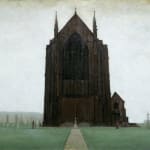L.S. Lowry (1887-1976)
Laurence Stephen Lowry was unique among British artists in making the industrialization of the city his lifelong focus. Although his paintings show the influence of nineteenth century French Impressionists such as Georges Seurat, Lowry’s style remained entirely his own. As a modern painter, he considered it essential to portray the public rituals of daily urban life of the working class. Punctuated by factory whistles and school bells, life in the slums was cramped and most often monotonous. During the economic depression of the 1920s, Lowry developed his vision of ‘poverty and gloom’. Unemployment, diphtheria or scarlet fever took a toll on entire communities.
The impact of the industrial revolution seemed void at first sight on Sunday’s ritual of visiting the church. Although women would continue to go to service, men would no longer participate and belief and religious sentiment was slowly vanishing.
In the heart of the coal-mining community in Greater Manchester, the Anglican St Augustine’s Church was nicknamed Miners’ Cathedral. The Lowry’s lived nearby, on 117 Station Road, between 1909 and 1948, contributing to the artist’s awareness of its decay with the depression. The stern portrait of St Augustine’s Church is particularly important since it reveals in an indirect way Lowry’s preoccupation with the struggle of workmen’s everyday life. The emptiness of the air and the fragile scatter of gravestones surrounding the church are spotlighted by the play between the bone-white sky and coal-black building.[1]
[1] T.J. Clark, “Lowry’s Other England”, in: op.cit., p. 26
[2] W. Sasnal, “Destiny at the dark end of the street. Lowry at Tate Britain II”, Tate Etc., 28, Summer 2013
Provenance
Sotheby’s, London, 26 November 1997, lot 89Crane Kalman Gallery, London
Mr. & Mrs. Olof Söderblom, United Kingdom
Crane Kalman Gallery, London, 2012
Private collection, United States
Exhibitions
Nottingham, Djanogly Art Gallery, Lowry, 16 November 2011 – 5 February 2012, cat.no. 17, p. 29
London, Tate Britain, Lowry and the Painting of Modern Life, 25 June – 20 October 2013, fig. 3, pp. 26-27



